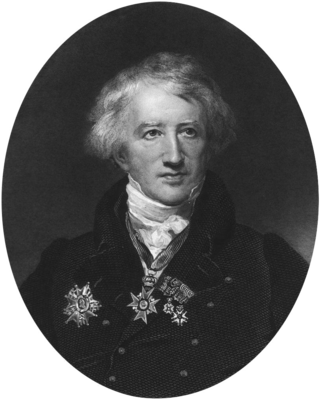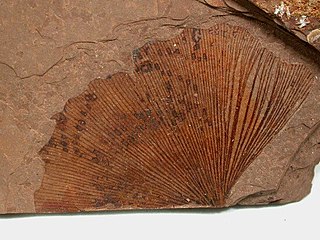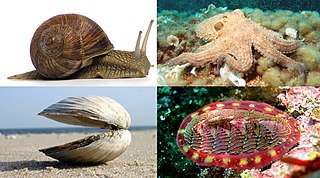
A chordate is an animal of the phylum Chordata. All chordates possess, at some point during their larval or adult stages, five synapomorphies, or primary physical characteristics, that distinguish them from all the other taxa. These five synapomorphies include a notochord, dorsal hollow nerve cord, endostyle or thyroid, pharyngeal slits, and a post-anal tail. The name “chordate” comes from the first of these synapomorphies, the notochord, which plays a significant role in chordate structure and movement. Chordates are also bilaterally symmetric, have a coelom, possess a circulatory system, and exhibit metameric segmentation.

A fossil is any preserved remains, impression, or trace of any once-living thing from a past geological age. Examples include bones, shells, exoskeletons, stone imprints of animals or microbes, objects preserved in amber, hair, petrified wood and DNA remnants. The totality of fossils is known as the fossil record.

Ammonoids are a group of extinct marine mollusc animals in the subclass Ammonoidea of the class Cephalopoda. These molluscs, commonly referred to as ammonites, are more closely related to living coleoids than they are to shelled nautiloids such as the living Nautilus species. The earliest ammonites appeared during the Devonian, with the last species vanishing during the Cretaceous–Paleogene extinction event.

Arachnida is a class of joint-legged invertebrate animals (arthropods), in the subphylum Chelicerata. Arachnida includes, among others, spiders, scorpions, ticks, mites, pseudoscorpions, harvestmen, camel spiders, whip spiders and vinegaroons.

Jean Léopold Nicolas Frédéric, Baron Cuvier, known as Georges Cuvier, was a French naturalist and zoologist, sometimes referred to as the "founding father of paleontology". Cuvier was a major figure in natural sciences research in the early 19th century and was instrumental in establishing the fields of comparative anatomy and paleontology through his work in comparing living animals with fossils.

The gastropods, commonly known as slugs and snails, belong to a large taxonomic class of invertebrates within the phylum Mollusca called Gastropoda.

Pseudoscorpions, also known as false scorpions or book scorpions, are small, scorpion-like arachnids belonging to the order Pseudoscorpiones, also known as Pseudoscorpionida or Chelonethida.

A living fossil is an extant taxon that cosmetically resembles related species known only from the fossil record. To be considered a living fossil, the fossil species must be old relative to the time of origin of the extant clade. Living fossils commonly are of species-poor lineages, but they need not be. While the body plan of a living fossil remains superficially similar, it is never the same species as the remote relatives it resembles, because genetic drift would inevitably change its chromosomal structure.

Homo is the genus that emerged in the genus Australopithecus that encompasses the extant species Homo sapiens, plus several extinct species classified as either ancestral to or closely related to modern humans, most notably H. erectus and H. neanderthalensis. The oldest member of Homo is H. habilis with records of just over 2 million years ago. However, a recent phylogenetic study in hominins using morphological, molecular and radiometric information, dates the emergence of Homo at 3.3 Ma. Homo, together with the genus Paranthropus, is probably sister to Australopithecus africanus, which itself had previously split from the lineage of Pan, the chimpanzees.
Paleoanthropology or paleo-anthropology is a branch of paleontology and anthropology which seeks to understand the early development of anatomically modern humans, a process known as hominization, through the reconstruction of evolutionary kinship lines within the family Hominidae, working from biological evidence and cultural evidence.

The Cradle of Humankind is a paleoanthropological site and is located about 50 km (31 mi) northwest of Johannesburg, South Africa, in the Gauteng province. Declared a World Heritage Site by UNESCO in 1999, the site is home to the largest concentration of human ancestral remains anywhere in the world. The site currently occupies 47,000 hectares (180 sq mi) and contains a complex system of limestone caves. The registered name of the site in the list of World Heritage Sites is Fossil Hominid Sites of South Africa.

Biostratigraphy is the branch of stratigraphy which focuses on correlating and assigning relative ages of rock strata by using the fossil assemblages contained within them. The primary objective of biostratigraphy is correlation, demonstrating that a particular horizon in one geological section represents the same period of time as another horizon at a different section. Fossils within these strata are useful because sediments of the same age can look completely different, due to local variations in the sedimentary environment. For example, one section might have been made up of clays and marls, while another has more chalky limestones. However, if the fossil species recorded are similar, the two sediments are likely to have been laid down around the same time. Ideally these fossils are used to help identify biozones, as they make up the basic biostratigraphy units, and define geological time periods based upon the fossil species found within each section.

Ostriches are large flightless birds. They are the heaviest living birds, and lay the largest eggs of any living land animal. With the ability to run at 70 km/h (43.5 mph), they are the fastest birds on land. They are farmed worldwide, with significant industries in the Philippines and Namibia. Ostrich leather is a lucrative commodity, and the large feathers are used as plumes for the decoration of ceremonial headgear. Ostrich eggs have been used by humans for millennia.

Fossil Butte National Monument is a United States National Monument managed by the National Park Service, located 15 miles (24 km) west of Kemmerer, Wyoming, United States. It centers on an assemblage of Eocene Epoch animal and plant fossils associated with Fossil Lake—the smallest lake of the three great lakes which were then present in what are now Wyoming, Utah, and Colorado. The other two lakes were Lake Gosiute and Lake Uinta. Fossil Butte National Monument was established as a national monument on October 23, 1972.

Acacia, commonly known as the wattles or acacias, is a large genus of shrubs and trees in the subfamily Mimosoideae of the pea family Fabaceae. Initially, it comprised a group of plant species native to Africa and Australasia. The genus name is New Latin, borrowed from the Greek ἀκακία, a term used by Dioscorides for a preparation extracted from the leaves and fruit pods of Vachellia nilotica, the original type of the genus. In his Pinax (1623), Gaspard Bauhin mentioned the Greek ἀκακία from Dioscorides as the origin of the Latin name.
The Cypriot mouse is a species of mouse endemic to Cyprus. Its primary habitat seems to be the vineyards and fields of the Troödos Mountains region.

Ginkgo is a genus of non-flowering seed plants. The scientific name is also used as the English name. The order to which it belongs, Ginkgoales, first appeared in the Permian, 270 million years ago, and Ginkgo is now the only living genus within the order. The rate of evolution within the genus has been slow, and almost all its species had become extinct by the end of the Pliocene. The sole surviving species, Ginkgo biloba is only found in the wild in China, but is cultivated around the world. The relationships between ginkgos and other groups of plants are not fully resolved.

Mollusca is the second-largest phylum of invertebrate animals after the Arthropoda, the members of which are known as molluscs or mollusks. Around 85,000 extant species of molluscs are recognized. The number of fossil species is estimated between 60,000 and 100,000 additional species. The proportion of undescribed species is very high. Many taxa remain poorly studied.
Caririemys is an extinct genus of side-necked turtles, belonging to the Pelomedusoides of the family Euraxemydidae. The type species is C. violetae. A single fossil of an individual was found in the Santana Formation in Brazil, an 80-million-year-old Late Cretaceous deposit that has so far preserved other fossil reptiles such as dinosaurs and crocodilians.

Malapa is a fossil-bearing cave located about 15 kilometres (9.3 mi) northeast of the well known South African hominid-bearing sites of Sterkfontein and Swartkrans and about 45 kilometres (28 mi) north-northwest of Johannesburg, South Africa. It is situated within the Cradle of Humankind World Heritage Site.
















